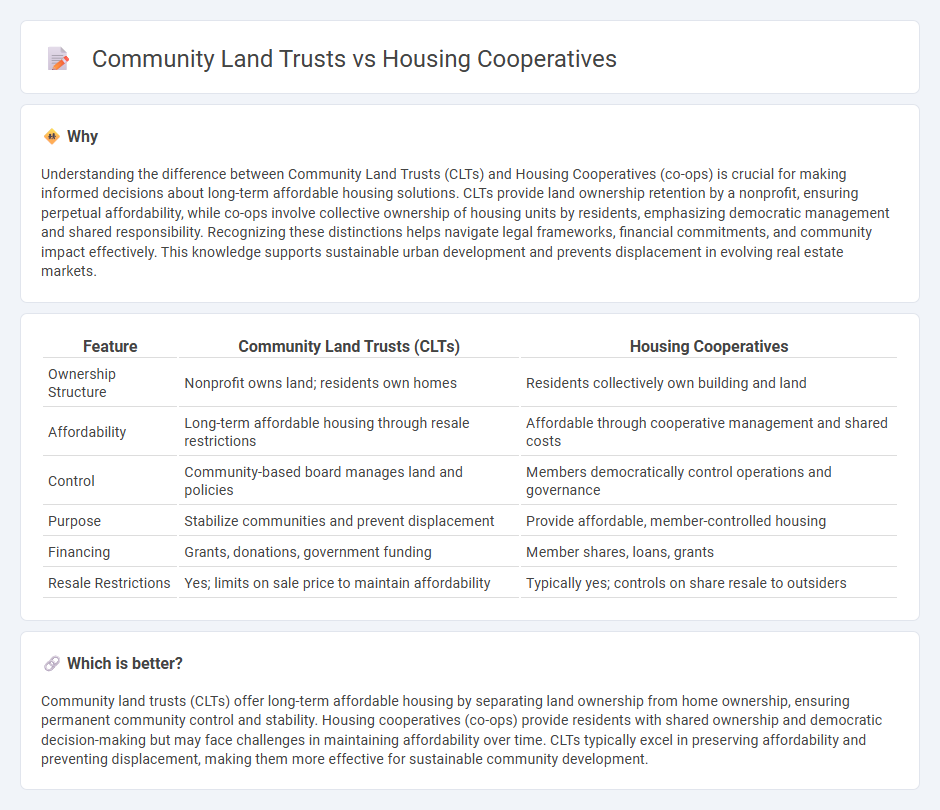
Community land trusts preserve affordable housing by separating land ownership from housing ownership, allowing residents to buy homes at below-market prices while the trust retains the land. Housing cooperatives offer shared ownership where residents collectively manage the property and hold shares in the cooperative, promoting democratic control and stability. Discover how these models can transform housing affordability and community empowerment.
Why it is important
Understanding the difference between Community Land Trusts (CLTs) and Housing Cooperatives (co-ops) is crucial for making informed decisions about long-term affordable housing solutions. CLTs provide land ownership retention by a nonprofit, ensuring perpetual affordability, while co-ops involve collective ownership of housing units by residents, emphasizing democratic management and shared responsibility. Recognizing these distinctions helps navigate legal frameworks, financial commitments, and community impact effectively. This knowledge supports sustainable urban development and prevents displacement in evolving real estate markets.
Comparison Table
| Feature | Community Land Trusts (CLTs) | Housing Cooperatives |
|---|---|---|
| Ownership Structure | Nonprofit owns land; residents own homes | Residents collectively own building and land |
| Affordability | Long-term affordable housing through resale restrictions | Affordable through cooperative management and shared costs |
| Control | Community-based board manages land and policies | Members democratically control operations and governance |
| Purpose | Stabilize communities and prevent displacement | Provide affordable, member-controlled housing |
| Financing | Grants, donations, government funding | Member shares, loans, grants |
| Resale Restrictions | Yes; limits on sale price to maintain affordability | Typically yes; controls on share resale to outsiders |
Which is better?
Community land trusts (CLTs) offer long-term affordable housing by separating land ownership from home ownership, ensuring permanent community control and stability. Housing cooperatives (co-ops) provide residents with shared ownership and democratic decision-making but may face challenges in maintaining affordability over time. CLTs typically excel in preserving affordability and preventing displacement, making them more effective for sustainable community development.
Connection
Community land trusts and housing cooperatives both promote affordable homeownership by separating land ownership from housing ownership, allowing residents to control and maintain their living environment. These models emphasize collective ownership and long-term affordability, reducing speculative market pressures and stabilizing neighborhoods. Through shared governance and resident participation, they strengthen community resilience and ensure equitable access to housing.
Key Terms
Shared Ownership
Housing cooperatives enable members to collectively own and manage their housing, emphasizing democratic control and shared maintenance responsibilities, while community land trusts retain land ownership to ensure long-term affordability with residents owning their homes but leasing the land. Shared ownership in housing cooperatives involves members holding shares proportional to their stake, whereas community land trusts separate ownership of the land from the property to prevent market speculation. Discover how these models offer sustainable pathways to affordable housing through shared ownership structures.
Collective Governance
Housing cooperatives empower residents with collective governance through elected boards that make decisions on property management and community policies, fostering democratic control and shared responsibility. Community land trusts also emphasize collective stewardship but focus on separating land ownership from housing ownership to ensure long-term affordability and community control over land use. Explore deeper insights into how these models balance collective governance and sustainable housing solutions.
Land Stewardship
Housing cooperatives empower residents with collective ownership and decision-making over their buildings, fostering strong community control but often without direct oversight of the surrounding land. Community land trusts hold ownership of land separately from housing structures, ensuring long-term stewardship, land affordability, and protection from market speculation through a nonprofit entity. Explore how these models uniquely manage land stewardship to create sustainable, equitable housing solutions.
Source and External Links
Housing Cooperative - A legal entity that owns real estate, providing a form of housing tenure where members hold shares granting them occupancy rights.
Housing Co-ops - Empowers residents with ownership and responsibility by allowing them to collectively own and manage their housing through a cooperative model.
HDFC Coops - A type of limited-equity cooperative in New York City that provides affordable housing options with reduced real estate taxes and income restrictions.
 dowidth.com
dowidth.com